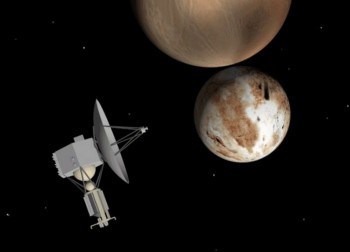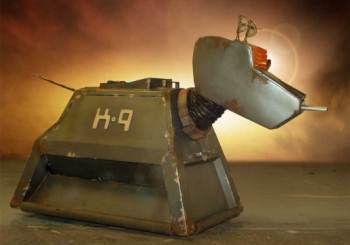When the Doctor Chases New Horizons…
Richard Forbes is a writer at Kasterborous Doctor Who News and Reviews - All the latest Doctor Who news and reviews with our weekly podKast, features and interviews, and a long-running forum.
Pluto, the red planet? The first images from the New Horizons probe’s historic flyby of Pluto and its moons have materialised, travelling over 5.3 billion kilometres to Earth to be received by Australia’s own Canberra Deep Space Communication Complex. Take a good look, folks! The world is party once again to one of those rare moments when our view of the solar system is forever changed.
Personally, I wasn’t much older than twelve when I first heard about the New Horizons mission to Pluto, then soon to be launched. Now, more than nine years later, I would experience the flyby as a University graduate, myself. It’s been a long wait for me and I’m sure, a far longer wait for the crew behind New Horizons, like Alan Stern, the mission’s leader, or Alice Bowman, Mission Operations manager; the latter was first on the scene when the probe’s telemetry was lost briefly (but terrifyingly) on July 4 due a computer glitch – a setback which left staff camping out on the office floor that night.

By popular demand, the SETI Institute has proposed a list of names to the IAU for the naming of geographic features on Pluto and Charon, including ‘Tardis’ and ‘Gallifrey’.
Those sleepless nights would soon pay off however with the probe returning online and carrying on with its extraordinary mission to capture images and collect data from Pluto, billions of miles from Earth, while hurling past the icy world at over 49,600 km/h (30,800 mph). Despite all of those times you may have spent pondering as a child about what Pluto might look like when your school textbooks only ever had ‘artist’s depictions’ of Pluto… neither our personal perception of Pluto, nor our textbooks shall ever be the same. Like those who remember the Apollo moon landing or Voyager 2’s flyby of Neptune, you (may) be a part of one of the last generations on Earth to live before the ‘face’ of this mysterious ‘dwarf planet’, one of the universe’s many secrets, became public knowledge, before it became ingrained in our collective memory as just another ‘fact’ to learn. We learnt it here, now, right then as these first pictures arrived.
When I thought about that, part humbled, part awestruck, I wondered if this is what it might feel like for the Doctor. In some ways, it’s hard to relate to a character who travels light-years across the universe to visit faraway worlds at the drop of a hat – our own vacations, at the very least, my vacations can often feel far more rehearsed and commercial.
Perhaps best put as Donna mused in Partners in Crime, with regards to her recent trip to Egypt: ‘I was going to go barefoot and everything. And then it’s all bus trips and guidebooks and don’t drink the water, and two weeks later you’re back home. It’s nothing like being with [the Doctor]. You may have felt the same at one time too. How, after all, can tourist trips to well renowned locales taken by millions each year, over as quick as they begin, ever compare to an adventure in the TARDIS? I doubt it could. But that doesn’t mean that we’re hopeless in understanding the Doctor, I’d argue.

Originally K9 was to be named ‘Pluto’ after the Disney character, but Disney refused to grant permission.
Nay, I’d say it’s moments like these where we understand what it’s like to live the Doctor’s life… traveling from planet to planet… to discover new worlds and lay his eyes on them for the first time. These are Taleb’s ‘black swan’ moments, when a new fact emerges… a new visual… and our understanding of the universe is never the same. The Doctor runs towards these moments with childlike enthusiasm – see, Mummy on the Orient Express, for example, as the Twelfth Doctor rambles on with praise for a planet ‘made entirely of shrubs’ – his enthusiasm for the world reminds me of us today; that same passion to experience the universe anew shines through the hundreds of tweets, articles, posts and casual banter about the New Horizons mission.
After all, the Doctor’s character was never written in a vacuum. If you want to understand the Doctor better, all one ever needs to do is look at the world which inspired him. The space race kicked off with Sputnik’s iconic telemetry signals; from 1957 to 1963, I can only imagine how different our world must have felt in such a short time with each milestone: the first man and woman in space, the first piece of human technology to impact on another celestial body than Earth (Luna 2), the first images from the far side of the moon… etc.
Why did we travel to the stars then?
Beyond simple nationalism, the obvious answer is curiosity… a strong will to discover the final frontier. That desire to explore, to touch down on alien land and experience the unknown, is at the heart of our latest mission to Pluto – a way of life, Series 7’s The Power of Three reminds us, we share with the Doctor. ‘This is one corner of one country in one continent on one planet that’s a corner of a galaxy that’s a corner of a universe that is forever growing and shrinking and creating and destroying and never remaining the same for a single millisecond. And there is so much, so much to see,’ says the Doctor to Amy. He adds, ‘I’m not running away from things, I am running to them before they flare and fade forever.’
Today we’ve visited Pluto with the same kind of passion to experience the great unknown. It makes me wonder if the Doctor, the hero we all know and love, isn’t simply a distillation of all the great mortal heroes of our own race to space… Valentina Tereshkova, Neil Armstrong, Margaret Hamilton, the crew at Space Center Houston … the astronauts, the boffins and wonks, the visionaries … everyone in those teams who made those voyages a reality.

The Doctor last visited Pluto in Robert Holmes’ The Sun Makers (1977).
I hadn’t thought of it that way before, to think of Doctor Who, not simply as an exploration of one alien’s travels abroad, the silly old buffer in a box, but a celebration of our own curiosity and our own industriousness – those values came from somewhere and it’s no less apparent today than ever. Remember, after all, that this whole elaborate flyby, a ‘great spirit of adventure’ in and of itself, begun just as the Doctor’s journey did as a mild curiosity in a junkyard tiny observatory in Flagstaff, Arizona, when Clyde Tombaugh, no older than twenty four years old himself at the time, found Pluto, having scavenged thousands of images of the night sky – all part of the observatory’s mission to find the ninth planet and resolve Percival Lowell’s quest for ‘Planet X’. Today, some of Tombaugh’s ashes fly aboard New Horizons; inscribed on the canister reads ‘interned herein are remains of American Clyde W. Tombaugh, discoverer of Pluto […]’
Indeed, Tombaugh’s incredible work then, and all of the crew at New Horizons today help remind us that at the centre of Doctor Who lies a very real, profound and uniquely human interest in exploring new worlds and advance our understanding of the universe.
As for New Horizons? The little probe that could is expected to carry on through the heliosphere and beyond.
The post When the Doctor Chases New Horizons… appeared first on Kasterborous Doctor Who News and Reviews.
Christian Cawley's Blog
- Christian Cawley's profile
- 4 followers



